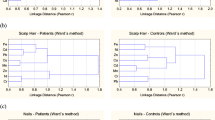Abstract
A change in the normal concentration of essential trace elements in the human body might lead to major health disturbances. In this study, hair samples were collected from 115 human subject, including 55 healthy people and 60 patients with prostate cancer. The concentrations of 20 trace elements (TEs) in these samples were measured by inductively coupled plasma-mass spectrometry. A support vector machine was used to investigate the relationship between TEs and prostate cancer. It is found that, among the 20 TEs, 10 (Mg P, K, Ca, Cr, Mn, Fe. Cu, Zn, and Se) are related to the risk of prostate cancer. These 10 TEs were used to build the prediction model for prostate cancer. The model obtained can satisfactorily distinguish the healthy samples from the cancer samples. Furthermore, the cross-validation by leaving-one method proved that the prediction ability of this model reaches as high as 95.8%. It is practical to predict the risk of prostate cancer using this model in the clinics
Similar content being viewed by others
References
A. Jermal, A. Thomas, T. Murray, and M. Thun, Cancer statistics,Cancer J Clin. 52, 23–47 (2002).
L. A. Cohen, Nutrition and prostate cancer,Ann. NY Acad. Sci. 963, 148–155 (2002).
S. Fujimoto, Studies on the relationships between blood trace metal concentrations and the clinical status of patients with cerebrovascular disease, gastric cancer, and diabetes mellitus,Hokkaido Igaku Zasshi 62, 913–932 (1987).
B. N. Gray, C. Walker, R. Barnard, and R. C. Bennett, Use of serum copper/zinc ratio in patients with large bowel cancer,J. Surg. Oncol. 20, 230–232 (1982).
J. A. Milner, Effect of selenium on virally induced and transplantable tumor models,Fed. Proc. 44, 2568–2572 (1985).
I. L. Mulay, R. Roy, B. E. Knox, N. H. Suhr, and W. E. Delaney, Trace-metal analysis of cancerous and non-cancerous human tissues,J. Natl. Cancer Inst. 47, 1–13 (1971).
E. N. Drake II and H. H. Sky-Peck, Discriminant analysis of trace element distribution in normal and malignant human tissues,Cancer Res. 49, 4210–4215 (1989).
H. H. Sky-Peck, Trace metals and neoplasia,Clin. Physiol. Biochem. 4, 99–111 (1986).
R. P. Mason, Effects of calcium channel blockers on cellular. apoptosis. Implications for carcinogenic potential,Cancer 85, 2093–2102 (1999).
M. J. Wargovith, Calcium, vitmin D and the prevention of gastrointestinal cancer, inNutrition and Cancer Prevention, T. E. Moon and M. S. Micozz, eds., Marcel Dekker, New York, p. 291 (1989).
D. L. Massart, B. G. M. Vandeginste, S. N. Deming, Y. Michotte, and L. Kaufman,Chemometrics: A Textbook, Elsevier, Amsterdam (1988).
M. Otto,Chemometrics, Statistics and Computer Application in Analytical Chemistry, Wiley, Weinheim (1999).
P. L. Leung, X. L. Li, Z. X. Li, and Y. C. Liang, Pattern recognition analysis to the variation of nasal-pharynx cancer patients’ trace element levels in samples of hair, whole blood, and tissue,Biol. Trace Element Res. 42(1), 1–7 (1994).
V. Vapnik,Statistical Learning Theory, Wiley, New York (1998).
C. Cortes and V. Vapnik, Support-vector networks,Machine Learning 20(3), 273–297 (1995).
R. Burbidge, M. Trotter, B. Buxton, and S. Holden, Drug design by machine learning: support vector machines for pharmaceutical data analysis,Comput. Chem. 26, 5–14 (2001).
C. H. Q. Ding and I. Dubchak, Multi-class protein fold recognition using support vector machines and neural networks,Bioinformatics 17, 349–358 (2001).
R. Karchin, K. Karplus, and D. Haussler, Classifying G-protein coupled receptors with support vector machines,Bioinformatics,18(1), 147–159 (2002).
Y. D. Cai, X. J. Liu, X. B. Xu, and K. C. Chou, Support vector machines for predicting HIV protease cleavage sites in protein,J. Comput. Chem. 23, 267–274 (2002).
V. N. Vapnik, An overview of statistical learning theory,IEEE Trans. Neural Networks 10, 988–999 (1999).
K.-R. Müller, S. Mika, G. RÄtsch, K. Tsuda, and B. Schölkopf, An introduction to kernel-based learning algorithms,IEEE Trans. Neural Networks 12(2), 181–201 (2001).
M. Yaman, D. Atici, S. Bakirdere, and I. Akdeniz, Comparison of trace metal concentrations in malign and benign human prostate,J. Med. Chem. 48, 630–635 (2005)
M. Brys, A. D. Nawrocka, E. Mickos, et al., Zinc and cadmium analysis in human prostate neoplasms,Biol. Trace Element Res. 59, 145–152 (1997).
Author information
Authors and Affiliations
Rights and permissions
About this article
Cite this article
Guo, J., Deng, W., Zhang, L. et al. Prediction of prostate cancer using hair trace element concentration and support vector machine method. Biol Trace Elem Res 116, 257–271 (2007). https://doi.org/10.1007/BF02698010
Received:
Revised:
Accepted:
Issue Date:
DOI: https://doi.org/10.1007/BF02698010




